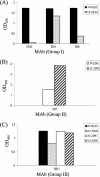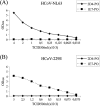Differentiation between human coronaviruses NL63 and 229E using a novel double-antibody sandwich enzyme-linked immunosorbent assay based on specific monoclonal antibodies
- PMID: 21084464
- PMCID: PMC3019789
- DOI: 10.1128/CVI.00355-10
Differentiation between human coronaviruses NL63 and 229E using a novel double-antibody sandwich enzyme-linked immunosorbent assay based on specific monoclonal antibodies
Abstract
Human coronaviruses (HCoVs) are responsible for respiratory tract infections ranging from common colds to severe acute respiratory syndrome. HCoV-NL63 and HCoV-229E are two of the four HCoVs that circulate worldwide and are close phylogenetic relatives. HCoV infections can lead to hospitalization of children, elderly individuals, and immunocompromised patients. Globally, approximately 5% of all upper and lower respiratory tract infections in hospitalized children are caused by HCoV-229E and HCoV-NL63. The latter virus has recently been associated with the childhood disease croup. Thus, differentiation between the two viruses is relevant for epidemiology studies. The aim of this study was to develop a double-antibody sandwich enzyme-linked immunosorbent assay (DAS-ELISA) as a potential tool for identification and differentiation between HCoV-NL63 and HCoV-229E. The nucleocapsid (N) proteins of HCoV-NL63 and HCoV-229E were expressed in an Escherichia coli system and used to immunize mice in order to obtain monoclonal antibodies (MAbs) specific for each virus. Three specific MAbs to HCoV-NL63, one MAb specific to HCoV-229E, and four MAbs that recognized both viruses were obtained. After their characterization, three MAbs were selected in order to develop a differential DAS-ELISA. The described assay could detect up to 3 ng/ml of N protein and 50 50% tissue culture infective doses/ml of virus stock. No cross-reactivity with other human coronaviruses or closely related animal coronaviruses was found. The newly developed DAS-ELISA was species specific, and therefore, it could be considered a potential tool for detection and differentiation of HCoV-NL63 and HCoV-229E infections.
Figures




Similar articles
-
Genetic variability of human coronavirus OC43-, 229E-, and NL63-like strains and their association with lower respiratory tract infections of hospitalized infants and immunocompromised patients.J Med Virol. 2006 Jul;78(7):938-49. doi: 10.1002/jmv.20645. J Med Virol. 2006. PMID: 16721849 Free PMC article.
-
Human coronavirus NL63 and 229E seroconversion in children.J Clin Microbiol. 2008 Jul;46(7):2368-73. doi: 10.1128/JCM.00533-08. Epub 2008 May 21. J Clin Microbiol. 2008. PMID: 18495857 Free PMC article.
-
The dominance of human coronavirus OC43 and NL63 infections in infants.J Clin Virol. 2012 Feb;53(2):135-9. doi: 10.1016/j.jcv.2011.11.011. Epub 2011 Dec 19. J Clin Virol. 2012. PMID: 22188723 Free PMC article.
-
An overview on the seven pathogenic human coronaviruses.Rev Med Virol. 2022 Mar;32(2):e2282. doi: 10.1002/rmv.2282. Epub 2021 Aug 2. Rev Med Virol. 2022. PMID: 34339073 Review.
-
Human coronaviruses 229E and NL63: close yet still so far.J Formos Med Assoc. 2009 Apr;108(4):270-9. doi: 10.1016/S0929-6646(09)60066-8. J Formos Med Assoc. 2009. PMID: 19369173 Free PMC article. Review.
Cited by
-
Recent advances in immunoassay technologies for the detection of human coronavirus infections.Front Cell Infect Microbiol. 2023 Jan 4;12:1040248. doi: 10.3389/fcimb.2022.1040248. eCollection 2022. Front Cell Infect Microbiol. 2023. PMID: 36683684 Free PMC article. Review.
-
Dual electrochemical sensing of spiked virus and SARS-CoV-2 using natural bed-receptor (MV-gal1).Sci Rep. 2021 Nov 26;11(1):22969. doi: 10.1038/s41598-021-02029-0. Sci Rep. 2021. PMID: 34836981 Free PMC article.
-
COVID-19 prediction based on hybrid Inception V3 with VGG16 using chest X-ray images.Multimed Tools Appl. 2023 Jun 5:1-18. doi: 10.1007/s11042-023-15903-y. Online ahead of print. Multimed Tools Appl. 2023. PMID: 37362699 Free PMC article.
-
Laboratory diagnosis of novel corona virus (2019-nCoV)-present and the future.Indian J Tuberc. 2020 Dec;67(4S):S128-S131. doi: 10.1016/j.ijtb.2020.09.023. Epub 2020 Oct 1. Indian J Tuberc. 2020. PMID: 33308658 Free PMC article. Review.
-
Editorial: Human coronavirus research: 20 years since the SARS-CoV outbreak.Front Microbiol. 2022 Sep 23;13:1035267. doi: 10.3389/fmicb.2022.1035267. eCollection 2022. Front Microbiol. 2022. PMID: 36212826 Free PMC article. No abstract available.
References
Publication types
MeSH terms
Substances
LinkOut - more resources
Full Text Sources
Other Literature Sources

